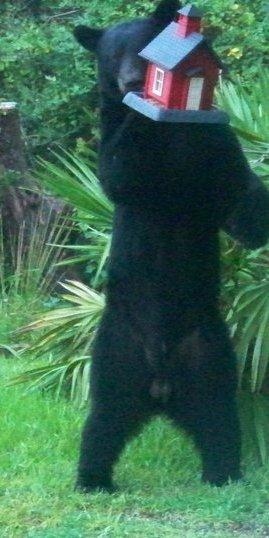
MILTON — Bears pursue the easiest food supply, according to the Florida Fish and Wildlife Conservation Commission, which for many Santa Rosa County homeowners means bears getting into their garbage.
One method to reduce the number of human-bear conflicts is to keep them out of garbage cans, according to FWC biologist, Kaitlin Goode. In 2015, over 25 percent of calls the FWC received on bears in Santa Rosa County related to trash.
Three years ago, the FWC reported the same tactic to reducing bear conflicts, saying, “The number of bear-related calls received by the (FWC) are on the rise in northwest Florida.”
Since then, calls dropped from 6,734 to 6,688 in 2014 and then to 6,094 last year, with an even greater drop in Santa Rosa County.
Despite this dip, the overall trend statewide shows calls moving from the low hundreds in the 1990s to the six-thousands over the past five years.
In Santa Rosa County, the area of the most human-bear conflict calls — called the conflict zone — stretches from Pace, to East Milton, to Navarre, to Gulf Breeze. The highest concentration of calls come from Navarre, with East Milton coming in second.
COMBATING THE BEAR PROBLEM
Goode, speaking to the Santa Rosa County Board of County Commissioners on Monday, said homeowners can request bear-proof trash cans from their waste service providers.
According to Ron Hixson, Environmental Manager for Santa Rosa County, each waste hauler’s agreement with the county includes providing bear-proof cans upon request for a fee per quarter. Hixson said the cost for Waste Management customers is $15.95 per quarter, for Waste Pro customers is $15 per quarter, and for Emerald Coast Utility Authority customers is $12 per quarter. These costs amount to between $4 and $5 a month.
The other solution, Goode said, is to keep trash cans “secure until the morning of pickup, after six o’clock.
“… The big thing is, it’s a community-wide effort. If one person on your street is not doing it (protecting garbage), then you’re going to have bears.”
AID FROM THE STATE
One program the FWC offers, Goode said, is the Conserve Wildlife Tag grant.
“We are currently trying to work with our top 14 counties, which Santa Rosa County falls into, and give money to (county governments) to start a bear-resistant trash can program.”
According to the Florida Highway Safety and Motor Vehicles department, the Conserve Wildlife license plate, enacted in 1998, costs $25 annually.
“We gave $20,000 to Okaloosa County in 2010 to start a pilot program there. There is a neighborhood, Willow Bend, in Okaloosa County that has not all bear-proof trash cans but they’ve got retro-fit kits on their trash cans, and so we did see a decrease in those areas. However, we saw an increase in the areas surrounding it because the bears moved from that neighborhood to the next.”
Adopting an ordinance mandating bear-proofing techniques in a county’s conflict zone could also mean state assistance.
Goode said there has been $500,000 appropriated “but the kicker is, 60 percent of that money has to go to counties with ordinances.” Right now, she said, Seminole is the only one in the top 14 to have an ordinance.
“Seminole County instated their ordinance, and we haven’t set a trap there for a bear. They all moved, either back into the woods because there was no longer food available … or they moved south into Orange County and Lake County,” Goode said.
District 4 Commissioner Rob Williamson, who said he’s seen a bear in his backyard in Sound Hammock in Navarre, said he would be in favor of an ordinance.
Commission Chairman Lane Lynchard directed Attorney Roy Andrews to see how the Seminole County ordinance could be applied in Santa Rosa County.
This article originally appeared on Santa Rosa Press Gazette: Lock up trash to repel bears, Florida Fish and Wildlife rep says
